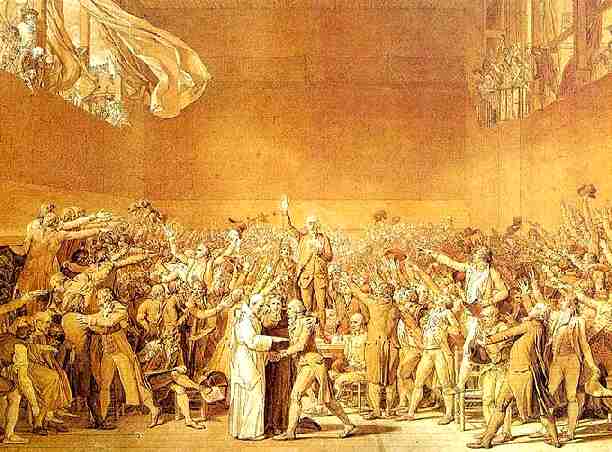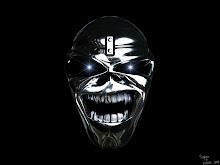 this picture shows a group of people reaching to shake each others hand. this picture describes the french rev because it shows fertility.
this picture shows a group of people reaching to shake each others hand. this picture describes the french rev because it shows fertility.Thursday, September 27
EXAM #1
 this picture shows a group of people reaching to shake each others hand. this picture describes the french rev because it shows fertility.
this picture shows a group of people reaching to shake each others hand. this picture describes the french rev because it shows fertility.Tuesday, September 25

Bastille fortress and state prison in Paris, located, until its demolition (started in 1789), near the site of the present Place de la Bastille. It was begun c.1369 by Hugh Aubriot, provost of the merchants [mayor] of Paris under King Charles V. Arbitrary and secret imprisonment by lettre de cachet gave rise to stories of horror, but actually the Bastille was generally used for persons of influence, and its regime for most political prisoners was mild. As a symbol of absolutism the Bastille was hated. It had strategic importance, for its guns commanded one of the gates of Paris. On July 14, 1789, a Parisian crowd stormed the Bastille in the hope of capturing ammunition. The governor was killed; the seven inmates, none of them political prisoners, were freed. The storming of the Bastille marks the beginning of the French Revolution, and July 14—Bastille Day—became the national holiday of republican France.
WEB SITE: http://www.infoplease.com/ce6/history/A0806447.html
 Danton, Georges Jacques 1759–94, French statesman, one of the leading figures of the French Revolution. A Parisian lawyer, he became a leader of the Cordeliers early in the Revolution and gained popular favor through his powerful oratory. A member of the Commune of Paris, he helped set the stage for the Aug., 1792, attack on the Tuileries and the overthrow of the monarchy. In the new republic, he became minister of justice and virtual head of the Provisional Executive Council. A member of the Convention, the national assembly, he dominated the first Committee of Public Safety (Apr.–July, 1793), created by the Convention as the chief governing body of France. When France suffered military reverses, Danton began to advocate a conciliatory foreign policy. He was not included (July, 1793) in the new Committee of Public Safety, and he retired from the capital. He returned in November when financial scandals involving his friends were revealed. Perhaps to help them, he advocated relaxation of emergency measures, particularly the Reign of Terror, and attacked the dictatorship of the committee. Soon after the committee had eliminated the extremists under Jacques René Hébert, it turned upon Danton and the “Indulgents” or moderates. On Mar. 30, 1794, Danton and his followers were charged with conspiracy to overthrow the government. The trial was a mockery, and Danton was guillotined. There has been much controversy as to his character, particularly between Alphonse Aulard, who defended him as a great patriot and statesman, and Albert Mathiez, who viewed him as a demagogue and a corrupt politician
Danton, Georges Jacques 1759–94, French statesman, one of the leading figures of the French Revolution. A Parisian lawyer, he became a leader of the Cordeliers early in the Revolution and gained popular favor through his powerful oratory. A member of the Commune of Paris, he helped set the stage for the Aug., 1792, attack on the Tuileries and the overthrow of the monarchy. In the new republic, he became minister of justice and virtual head of the Provisional Executive Council. A member of the Convention, the national assembly, he dominated the first Committee of Public Safety (Apr.–July, 1793), created by the Convention as the chief governing body of France. When France suffered military reverses, Danton began to advocate a conciliatory foreign policy. He was not included (July, 1793) in the new Committee of Public Safety, and he retired from the capital. He returned in November when financial scandals involving his friends were revealed. Perhaps to help them, he advocated relaxation of emergency measures, particularly the Reign of Terror, and attacked the dictatorship of the committee. Soon after the committee had eliminated the extremists under Jacques René Hébert, it turned upon Danton and the “Indulgents” or moderates. On Mar. 30, 1794, Danton and his followers were charged with conspiracy to overthrow the government. The trial was a mockery, and Danton was guillotined. There has been much controversy as to his character, particularly between Alphonse Aulard, who defended him as a great patriot and statesman, and Albert Mathiez, who viewed him as a demagogue and a corrupt politicianINFO FOUND ON : http://www.infoplease.com/ce6/people/A0814630.html
Friday, September 21
Monday, September 17
french revolution movie notes
shook foundation of europe, the revultion got rid of the cathlic church, greatest and bloodyest revolution, royal court finished 1682, queen has to make a baby a male baby, luey had a problem making a baby the people thought it was the wife but it was the king he had a medical problem that hurt him to get "happy in bed".
Friday, September 14
Thursday, September 13
french rev.
Many factors led to the revolution; to some extent the old order succumbed to its own rigidity in the face of a changing world; to some extent, it fell to the ambitions of a rising bourgeoisie, allied with aggrieved peasants and wage-earners and with individuals of all classes who had come under the influence of the ideas of the Enlightenment.
As the revolution proceeded and as power devolved from the monarchy to legislative bodies, the conflicting interests of these initially allied groups would become the source of conflict and bloodshed.Certainly, causes of the revolution must include all of the following:
Resentment of royal absolutism.
Resentment of the seigneurial system by peasants, wage-earners, and a rising bourgeoisie.
The rise of enlightenment ideals.
An unmanageable national debt, both caused by and exacerbating the burden of a grossly inequitable system of taxation.
Food scarcity in the years immediately before the revolution
As the revolution proceeded and as power devolved from the monarchy to legislative bodies, the conflicting interests of these initially allied groups would become the source of conflict and bloodshed.Certainly, causes of the revolution must include all of the following:
Resentment of royal absolutism.
Resentment of the seigneurial system by peasants, wage-earners, and a rising bourgeoisie.
The rise of enlightenment ideals.
An unmanageable national debt, both caused by and exacerbating the burden of a grossly inequitable system of taxation.
Food scarcity in the years immediately before the revolution
Tuesday, September 11
Political reformation
Political reformation
The course of the Reformation was different in England. There had long been a strong strain of anti-clericalism, and England had already given rise to the Lollard movement, which may have inspired the Hussites in Bohemia. By the 1520s, however, the Lollards were not an active force, or, at least, certainly not a mass movement. The different character of the English Reformation came rather from the fact that it was driven initially by the political necessities of Henry VIII. Henry had once been a sincere Catholic and had even authored a book strongly criticizing Luther, but he later found it expedient and profitable to break with the Papacy. In 1534 The Act of Supremacy made Henry Supreme Head of the Church of England. Between 1535 and 1540, under Thomas Cromwell, the policy known as the Dissolution of the Monasteries was put into effect. The veneration of some Saints, certain pilgrimages and some pilgrim shrines were also attacked. Huge amounts of church land and property passed into the hands of the crown and ultimately into those of the nobility and gentry. The vested interest thus created made for a powerful force in support of the dissolutions.
The course of the Reformation was different in England. There had long been a strong strain of anti-clericalism, and England had already given rise to the Lollard movement, which may have inspired the Hussites in Bohemia. By the 1520s, however, the Lollards were not an active force, or, at least, certainly not a mass movement. The different character of the English Reformation came rather from the fact that it was driven initially by the political necessities of Henry VIII. Henry had once been a sincere Catholic and had even authored a book strongly criticizing Luther, but he later found it expedient and profitable to break with the Papacy. In 1534 The Act of Supremacy made Henry Supreme Head of the Church of England. Between 1535 and 1540, under Thomas Cromwell, the policy known as the Dissolution of the Monasteries was put into effect. The veneration of some Saints, certain pilgrimages and some pilgrim shrines were also attacked. Huge amounts of church land and property passed into the hands of the crown and ultimately into those of the nobility and gentry. The vested interest thus created made for a powerful force in support of the dissolutions.
Religious influences for the Reformation
Religious influences for the Reformation
While there were some parallels between certain movements within humanism and teachings later common among the Reformers, the Reformation's principal arguments were based on "direct" Biblical interpretation. The Roman Catholic Church had for several centuries been the main purveyor in Europe of non-secular humanism: the neo-Platonism of the scholastics and the neo-Aristotelianism of Thomas Aquinas and his followers had made humanism a part of Church dogma. This was of course due to the Catholic Church's use of historic, religious tradition (including the Canonization of Saints) in the forming of its liturgy. Thus, when Luther and the other reformers adopted the standard of sola scriptura, making the Bible the sole measure of theology, they made the Reformation a reaction against the humanism of that time. Previously, the Scriptures had been seen by some as the pinnacle of a hierarchy of sacred texts, and on par with the oral traditions of the Church.
While there were some parallels between certain movements within humanism and teachings later common among the Reformers, the Reformation's principal arguments were based on "direct" Biblical interpretation. The Roman Catholic Church had for several centuries been the main purveyor in Europe of non-secular humanism: the neo-Platonism of the scholastics and the neo-Aristotelianism of Thomas Aquinas and his followers had made humanism a part of Church dogma. This was of course due to the Catholic Church's use of historic, religious tradition (including the Canonization of Saints) in the forming of its liturgy. Thus, when Luther and the other reformers adopted the standard of sola scriptura, making the Bible the sole measure of theology, they made the Reformation a reaction against the humanism of that time. Previously, the Scriptures had been seen by some as the pinnacle of a hierarchy of sacred texts, and on par with the oral traditions of the Church.
Friday, September 7
Subscribe to:
Comments (Atom)






